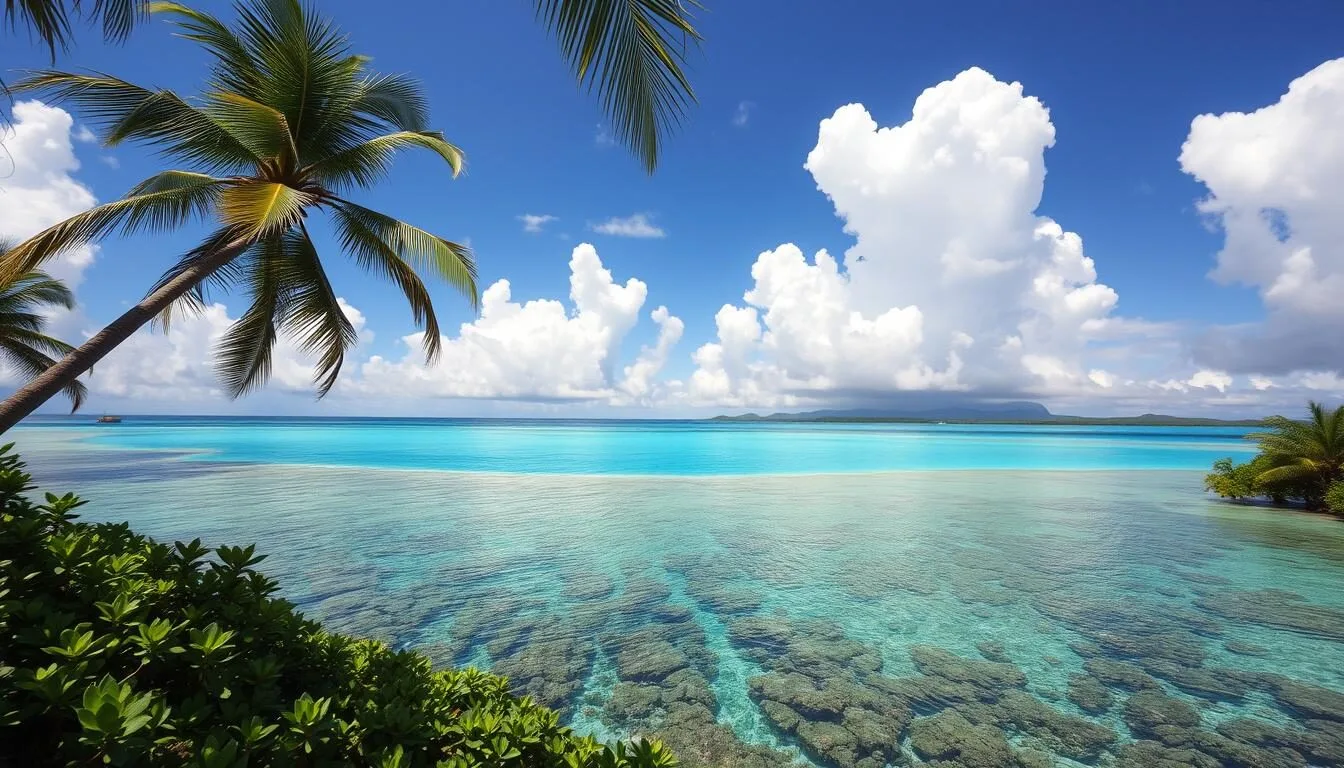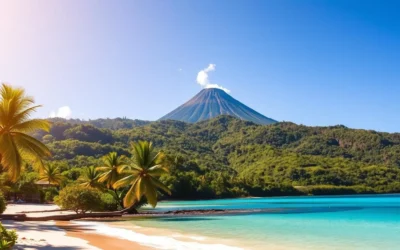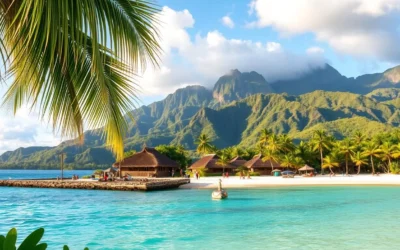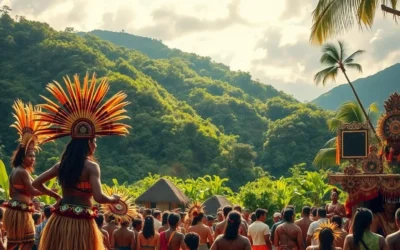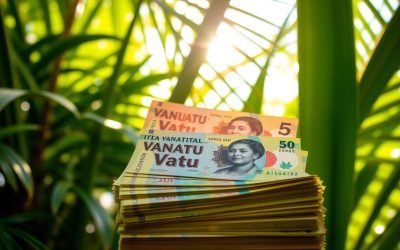✓ Accommodations✓ Flights✓ Rental Cars✓ Tours & Activities
Did you know that Vanuatu’s vast archipelago of 83 islands stretches over 1,300km of the South Pacific Ocean? This results in a diverse range of climate conditions, making the timing of your visit crucial to your island experience.
The northern islands are hot and wet all year round, while the southern and central islands have distinct dry and wet seasons. Understanding these climate patterns will help you choose the perfect time for your visit, whether you prefer drier months or are prepared for occasional tropical showers.
This comprehensive guide will walk you through the best time to visit Vanuatu based on weather conditions, ensuring you’re well-prepared for your island getaway.
Understanding Vanuatu’s Tropical Climate
Vanuatu’s tropical climate is characterized by relatively stable temperatures throughout the year. This stability is a significant factor for travelers planning their trip.
Geographic Location and Its Impact on Weather
Vanuatu is an island nation located in the Pacific Ocean, northeast of Australia. Its geographic location subjects it to a tropical marine climate, with the weather influenced by the surrounding ocean. The maritime influence helps moderate temperatures.
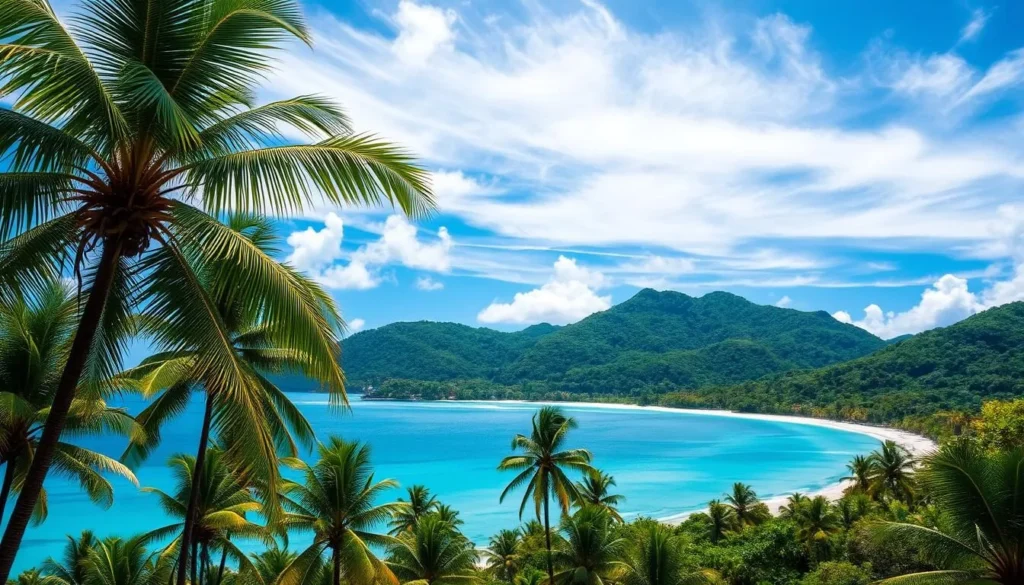
Year-Round Temperature Patterns
Average temperatures in Vanuatu range from 21°C to 28°C (70°F to 82°F), depending on the season. Although temperatures can fluctuate, they rarely drop below 19°C or rise above 32°C on any given day. The temperature variations between the wet and dry seasons are relatively slight.
| Season | Average Temperature Range | Humidity Level |
|---|---|---|
| Wet Season (Oct-Mar) | 24°C – 28°C | High |
| Dry Season (Apr-Sep) | 21°C – 25°C | Moderate |
Understanding these temperature patterns and humidity levels can help you plan your trip to Vanuatu at the best time for your preferences.
Vanuatu’s Two Distinct Seasons
Understanding Vanuatu’s two distinct seasons is crucial for planning a trip that meets your weather preferences. The country’s tropical climate is characterized by a dry season and a wet season, each offering unique experiences and conditions for travelers.
Dry Season: April to September
The dry season in Vanuatu, spanning from April to September, is marked by more stable and pleasant weather conditions. During this period, you can expect lower humidity and reduced rainfall, making it an ideal time for outdoor activities such as hiking, diving, and exploring the islands. Temperatures range from 22°C to 28°C, providing comfortable conditions for a variety of pursuits.
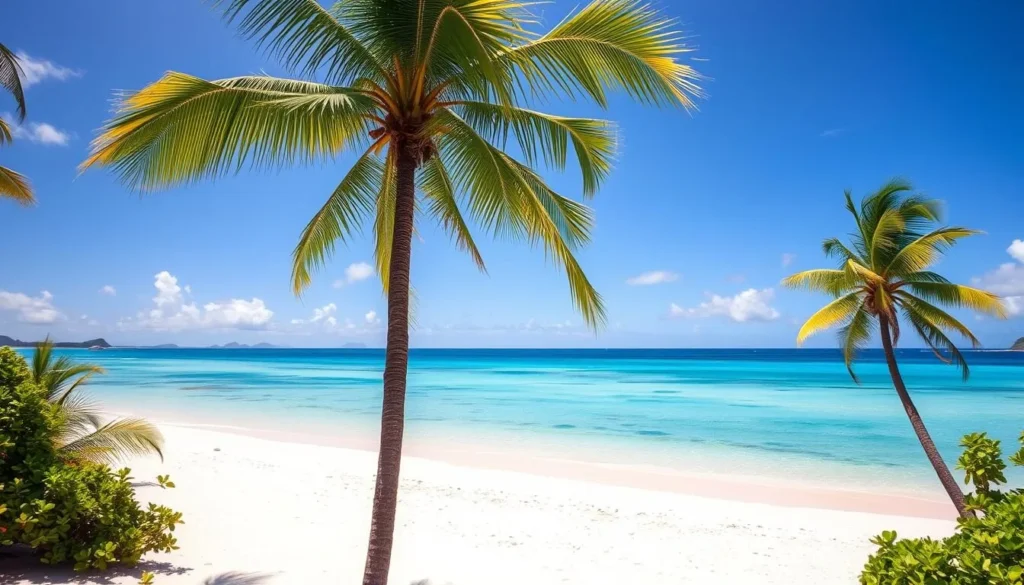
Wet Season: October to March
Vanuatu’s wet season, which runs from October to March, corresponds with the summer months in the Southern Hemisphere. This period is characterized by higher temperatures, averaging between 25°C and 29°C, and increased humidity. While the wet season brings unpredictable and sometimes heavy rainfall, the rain showers are often followed by sunshine, and the landscapes become lush and vibrant. Some key aspects to consider during the wet season include:
- Higher rainfall, particularly on the northern islands, which can receive up to 4000 mm of rain annually.
- Increased humidity, which can impact comfort levels for some travelers.
- The potential for storms and heavy showers, although these are typically short-lived.
- The advantages of fewer tourists and potentially lower prices, making it an attractive time for budget-conscious travelers.
Despite the weather considerations, the wet season has its charm, with the islands appearing at their most lush and green. You can still enjoy a variety of activities, and the occasional rain showers can be a refreshing respite from the heat.
Vanuatu: Best Months for a Weather-Savvy Trip
For travelers seeking the perfect blend of pleasant weather and smaller crowds, Vanuatu’s shoulder seasons are worth considering. The best months to visit Vanuatu for a combination of great weather, lower prices, and fewer crowds are the shoulder months of May, early June, and September.
May to Early June: Ideal Weather with Fewer Crowds
Visiting Vanuatu in May or early June offers ideal weather conditions with fewer tourists compared to the peak months. The dry season is well-established by May, ensuring warm, sunny days with minimal rainfall. As the peak tourist season has not yet reached its zenith, you can enjoy popular attractions without the crowds, making for a more relaxed and enjoyable experience.
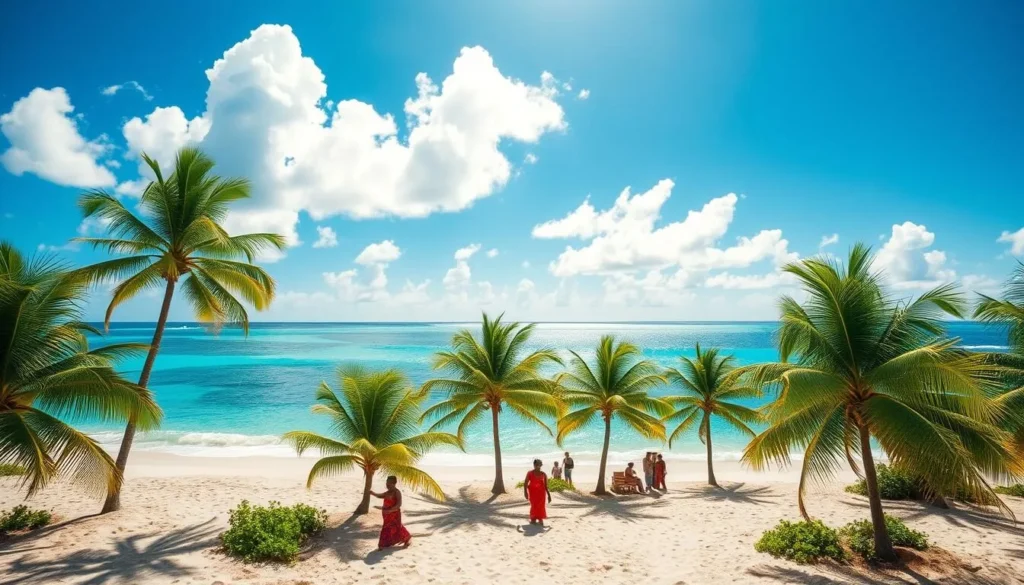
September: Perfect Balance of Weather and Value
September stands out as another optimal time to visit Vanuatu, offering a perfect balance of favorable weather and good value. Falling at the end of the dry season but after the peak tourist period, September brings warm, sunny days with temperatures around 23-27°C (73-81°F) and relatively low humidity. This makes it ideal for both land and water activities. Understanding how September’s position in the tourism calendar affects availability and pricing can help you plan a more cost-effective trip without sacrificing weather quality.
Rainfall Patterns Throughout the Year
To make the most of your trip to Vanuatu, it’s essential to understand the island’s rainfall patterns. Vanuatu’s tropical climate means that rainfall varies significantly throughout the year, impacting your travel plans and the activities you can enjoy.
Wettest Months: January to March
The months from January to March are the wettest in Vanuatu, with heavy rainfall and high humidity. During this period, the island experiences significant precipitation, with rain occurring on most days. This can impact your outdoor plans, but the lush green landscapes that result from the rainfall can be a beautiful backdrop for your trip.
Driest Months: July and August
In contrast, July and August are the driest months in Vanuatu, characterized by minimal rainfall and low humidity. The weather in August remains cool, with daily temperatures ranging from 18 to 24°C, making it ideal for outdoor activities like diving, with excellent visibility due to the clear waters.
| Month | Average Rainfall Days | Temperature Range (°C) |
|---|---|---|
| July | 5-7 | 18-24 |
| August | 5 | 18-24 |
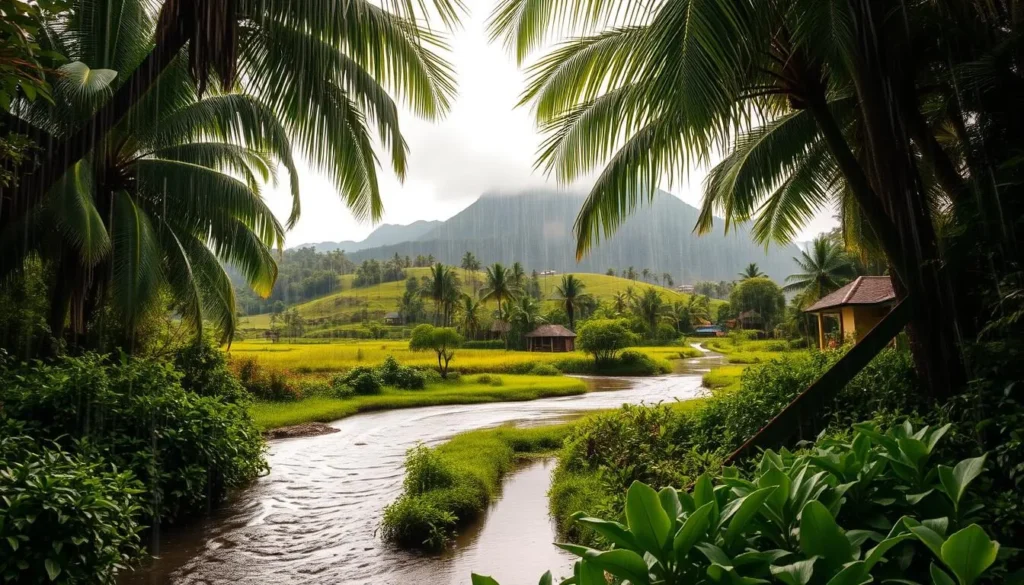
These months offer the most reliable weather patterns, with rain occurring on only a few days per month on average. The reduced rainfall creates ideal conditions for outdoor activities, and the clearer waters enhance the diving and snorkeling experience. Understanding these patterns helps you plan your trip during the best time for your preferred activities.
Sunshine and Cloud Cover by Month
Sunshine and cloud cover are key factors to consider when deciding the best time to visit Vanuatu. The island’s tropical climate means that sunshine hours and cloud cover vary significantly throughout the year.
Clearest Skies: May to October
From May to October, Vanuatu experiences its clearest skies, making it an ideal period for outdoor activities and sightseeing. During these months, you can expect plenty of sunshine, with minimal cloud cover. This period coincides with the dry season, characterized by less rain and fewer showers.
- Average sunshine hours peak during this period.
- Clear skies provide perfect conditions for photography and outdoor exploration.
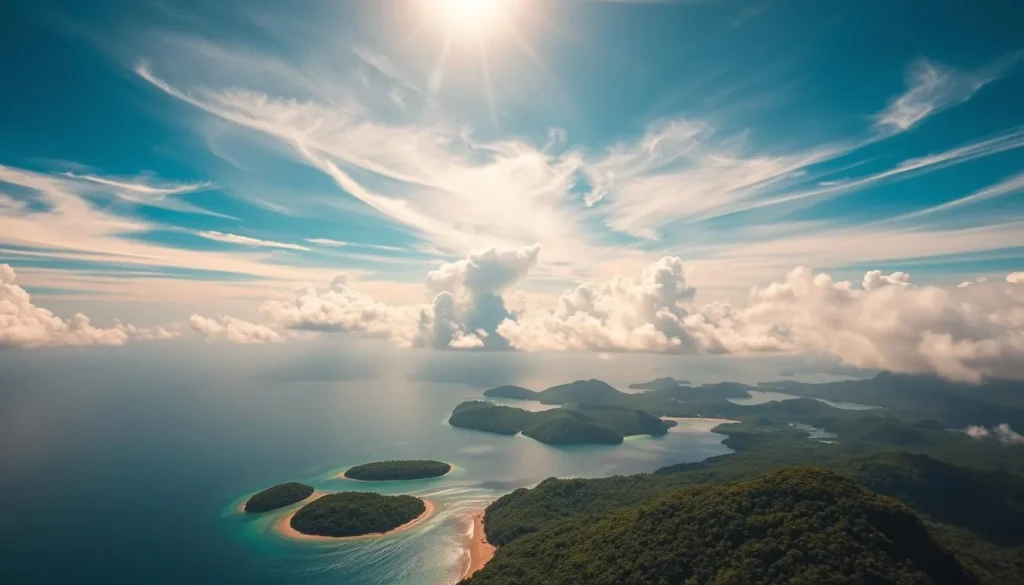
Most Overcast Periods: December to March
The months from December to March are marked by increased cloud cover, typical of Vanuatu’s wet season. Although it’s the cloudiest period, the islands still receive an average of 4-6 hours of sunshine per day. The cloud cover often builds up in the afternoon, potentially leading to short, sharp showers.
- Mornings are often sunny, with clouds gathering by afternoon.
- The dramatic cloud formations can create spectacular sunsets.
Humidity Levels and Comfort Factors
As you plan your trip to Vanuatu, understanding the humidity levels and comfort factors will be crucial for an enjoyable experience. Vanuatu’s tropical climate means that humidity is a significant factor in determining the comfort level of your visit.
Managing High Humidity
Managing high humidity is essential to ensure that your trip is comfortable. During the wet season, the humidity levels are relatively high, which can make outdoor activities feel more challenging. However, the dry season, which spans from April to September, offers more comfortable conditions with lower humidity levels, making it ideal for most holiday activities.
Beach/Pool Score for Outdoor Activities
The “beach/pool score” measures the ideal conditions for water-based recreation throughout the year in Vanuatu. This score peaks during the dry season months (April-September) when the combination of temperature, humidity, and cloud cover creates optimal conditions for beach activities. You’ll find that the best time to visit Vanuatu for a relaxing beach experience is during these months, with the water conditions being perfect for various activities.
Understanding how pool and beach comfort varies throughout the day helps you plan the timing of your water activities for maximum enjoyment. Some resorts offer excellent pool facilities for times when beach conditions might be less than ideal due to seasonal factors, ensuring that you have a great experience regardless of the time of your visit.
Best Months for Specific Activities in Vanuatu
Planning your trip to Vanuatu around the best times for beach activities and cultural exploration can enhance your overall experience. The island nation offers a variety of experiences that are weather-dependent.
Optimal Times for Beach Activities
The dry season, from April to September, is ideal for beach activities due to the calm seas and plenty of sunshine. May to early June is particularly great as the weather is pleasant with fewer crowds. You can enjoy swimming, snorkeling, and diving in optimal conditions.
- Enjoy calm seas and plenty of sunshine during the dry season.
- Experience pleasant weather with fewer crowds in May and early June.
Ideal Periods for Cultural Exploration
Vanuatu’s rich cultural heritage is showcased through various festivals and events. The Nagol Land Diving Festival on Pentecost Island is a significant cultural event that takes place every Saturday from April to June. Additionally, the Fanla Village Festival on Ambrym Island is held annually, featuring traditional dances and ceremonies.
- Experience the Nagol Land Diving Festival from April to June.
- Visit the Fanla Village Festival for a glimpse into traditional culture.
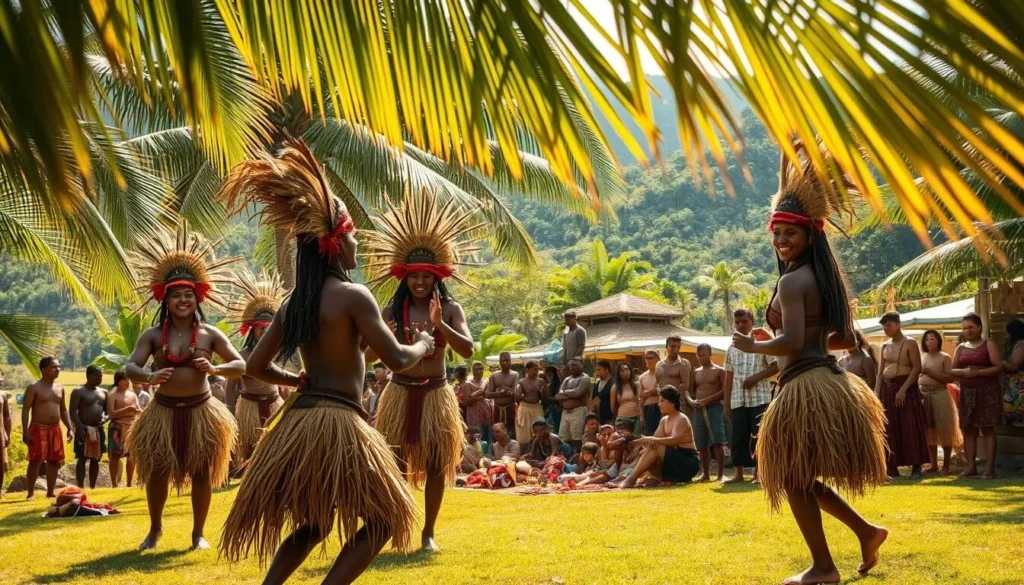
Month-by-Month Weather Guide to Vanuatu
To make the most of your visit to Vanuatu, it’s essential to understand the country’s seasonal weather patterns.
January to March: Hot and Wet
This period is characterized by high temperatures and significant rainfall. January to March is the wettest season, with frequent showers and high humidity. Temperatures range from 23 to 28°C across the central and southern islands, and from 25 to 30°C on the northern islands.
April to June: Transitioning to Dry Season
As Vanuatu transitions into the dry season, the weather becomes more favorable for outdoor activities. Temperatures range from 20 to 25°C, making it ideal for beach activities and cultural exploration. Humidity decreases, and rainfall becomes less frequent.

July to September: Peak Dry Season
This is the coolest and driest period in Vanuatu, with clear skies and comfortable temperatures ranging from 18 to 23°C. It’s the peak tourist season, ideal for snorkeling, diving, and other outdoor activities.
October to December: Transitioning to Wet Season
October marks the beginning of the wet season, with temperatures gradually increasing. November and December become hotter and more humid, with more frequent rainfall. However, the showers are often brief, leaving plenty of sunshine.
Navigating Vanuatu’s Tourist Seasons
The success of your Vanuatu trip hinges on understanding the island’s tourist seasons and planning accordingly. Vanuatu, a popular Pacific island destination, experiences varying levels of tourism throughout the year, affecting crowds, prices, and overall experience.
High Season: June to August and December to January
The high season in Vanuatu, which includes June to August and December to January, is characterized by peak tourist activity. During these periods, the island is bustling with visitors, leading to higher prices for accommodations and tourist services. If you’re looking for a vibrant atmosphere and don’t mind the crowds, this might be the best time for you to visit.
| Period | Characteristics | Best For |
|---|---|---|
| June to August | Peak tourist season, high prices | Families, those who enjoy a lively atmosphere |
| December to January | Holiday season, crowded, festive atmosphere | Travelers looking for a holiday vibe |
Shoulder Seasons: May, September to November
The shoulder seasons, which include May, September, October, and November, offer a more relaxed pace and better value for money. During these periods, the weather remains pleasant, and you’re likely to encounter fewer tourists, making it an ideal time to visit if you’re looking for a more serene experience. Flight prices from major hubs like Australia and New Zealand tend to be lower during these times, making it a cost-effective option for travelers.
Weather Considerations for Island Hopping
When planning a trip to Vanuatu, understanding the weather considerations for island hopping is crucial for a smooth and enjoyable journey. Vanuatu is an archipelago with diverse weather patterns across its islands, making it essential to plan your trip according to the seasonal weather variations.
Inter-Island Travel and Weather Impacts
Most resorts in Vanuatu are located on the southern islands, where the climate is less humid and receives significantly less rainfall, with some areas getting up to 2000mm of rain. When traveling between islands, it’s crucial to consider the weather impacts on inter-island travel. The wet season, which runs from October to March, can cause disruptions due to heavy rainfall and rough seas.
Planning Multi-Island Itineraries
To make the most of your time visit to Vanuatu, plan your multi-island itinerary according to the best time to visit each island. During the dry season, from April to September, you can enjoy a more relaxed pace and engage in various activities without the disruptions caused by wet weather. By understanding the weather patterns and planning accordingly, you can create an efficient travel schedule that allows you to explore multiple islands and make the most of your trip.
Packing Tips for Different Seasons in Vanuatu
To ensure you’re prepared for the diverse weather conditions in Vanuatu, it’s essential to pack wisely according to the season. Vanuatu’s climate varies significantly between the dry and wet seasons, and being prepared will enhance your travel experience.
Essential Items Year-Round
Regardless of the season, there are certain items you should always pack for a trip to Vanuatu. These include casual, modest clothing, a shawl or lightweight jacket for cooler evenings, bathers, a hat, sunglasses, snorkelling gear, reef shoes, walking shoes, sunscreen, and a small backpack. Lightweight, breathable clothing is a must due to the tropical climate. Additionally, consider packing clothing that can be easily mixed and matched to create multiple outfits.
| Item | Reason |
|---|---|
| Casual, modest clothing | Respect local culture and stay comfortable |
| Lightweight jacket | Cooler evenings, especially in the dry season |
| Snorkelling gear | Explore Vanuatu’s beautiful underwater world |
Season-Specific Packing Recommendations
For the wet season (October to March), consider packing quick-dry clothing and a lightweight rain jacket or poncho to keep you dry. Extra insect repellent is also a good idea due to the increased mosquito activity. During the dry season (April to September), light layers for cooler evenings are advisable, as temperatures can drop to 18-19°C (64-66°F).
Understanding how humidity affects clothing choices can also help you select appropriate fabrics for different seasons. For instance, lightweight cotton, linen, and moisture-wicking synthetics are ideal for Vanuatu’s climate. By adapting your packing list to the season, you’ll be well-prepared for a comfortable and enjoyable trip.
Conclusion: Making the Most of Your Vanuatu Visit
The ideal time to visit Vanuatu depends on your priorities and preferences. By understanding the weather patterns and tourist seasons, you can make an informed decision about when to plan your trip.
The shoulder months of May, early June, and September offer a great balance of good weather, lower prices, and fewer crowds. Whether you’re looking for beach activities or cultural experiences, Vanuatu’s diverse islands have something to offer. By being flexible and prepared, you can create a memorable experience in this tropical destination.
The above is subject to change.
Check back often to TRAVEL.COM for the latest travel tips and deals.
